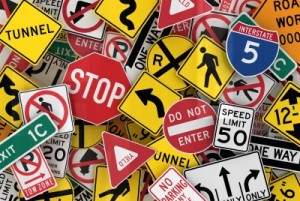Remember the day you first got your license? Whether it was a permit or the actual license, it was an exciting day for many reasons. You no longer had to depend on friends to drive you. You didn’t have to feel embarrassed waiting for your parents to pick you up in front of your friends. Honestly, it was a big moment in your life.
But to get to that milestone, you had to be a studious, alert driver who knew every single rule of the roadway…or at least the one’s asked in the driver’s test. The eye test. The fill-in-the-blank exam. And most importantly, the actual drive itself, complete with mirror checks, turn signal tests and the mighty parallel parking challenge. It was a lot to take in, for sure, but once you passed it was pure jubilation. You couldn’t wait to get down to your local car dealer to scout your first car, or maybe you already had one waiting in the driveway with a nice enticing bow on the hood.

Now fast forward a couple years or more and try and remember all those driving laws? How do you think you’d do on the test if it was presented to you? Good, bad or somewhere in between?
Sure, there were probably some modifications to the current rule book, but for the most part it’s stayed the same. And there’s a good chance you’ve failed some of the rules along the way. I know I have at one time or another. So let’s take a look at some of the more common driving laws we sometimes stumble over!
Turn Signals
Turn signals are obviously an important part with anyone’s driving, both for the driver and other vehicles on the road. Some drivers get all sorts of giddy with their turn signals (which is great) to let drivers behind and ahead of them know they’re getting ready for a right turn that’s a good 400 yards up the road. And then there’s the other section of drivers who don’t notify drivers behind them about when they’re turning, usually waiting until around twenty feet or less to do it. That causes abrupt braking and throws off more than just that car’s timing because there’s possibly a driver or two behind them breaking another rule.
Tailgating
Riding the coattails of a car is probably one of the most common things I see when behind the wheel. Doesn’t matter if it’s the highway or side street leading to your driveway. It’s aggressive driving and can pose a great danger to yourself, the driver in front of you and everyone else along the road should there be an abrupt stop up ahead. Does the general rule of thumb, “one car length with every 10 miles per hour of speed”, ring a bell?
Not Checking Every Angle When Merging
Only relying on one source when merging is a sure-fire way to cause an inconvenience to the flow of traffic. That one source being strictly your driver-side mirror and nothing more. Some drivers tend to forget about their blind spot and fail to turn and look properly through their window when merging. Many times this is a result of being too focused with the flow of traffic ahead and planning too far in advance which lane you’re going to overtake in the process. Remedy this by simply taking the time to check each and every angle of the lane you’re merging towards, ensuring there’s plenty of space and time for the other drivers to see you enter.
Speeding
Not much to really add to this other than the fact it’s illegal. Unless you’re planning a trip to the Autobahn, speeding is a no-no and is a danger to your reaction time. Always be aware of what the current speed limit is on the exact stretch of road and be extra aware when approaching a school zone.
Driving Distracted
While an entire post could be written about this one, driving distractions are quickly becoming one of the most common tags to accidents. Texting or talking on the phone. Eating or drinking. Daydreaming. Reaching for a fallen object on the floor of your car. These and more drop your reaction time down significantly and is a dangerous habit that every driver should nip in the bud immediately.
Not Wearing A Seat Belt
This one shouldn’t have to be on here at all, but is. Driving without a seat belt puts the driver at great risk of injury if they get into an accident. Thankfully law enforcement and regulations have created more awareness with the Click It or Ticket campaign where any driver pulled over not wearing a seat belt will be issued a citation. A good way to remember to wear your seat belt before turning on the ignition is that when you enter your car, run your hand along the driver’s side handle back towards your seat until you feel the seat belt. It sounds like a silly routine, but once you create a habit (however you do it), it sticks.
In conclusion, there’s no such thing as a “grey area” with any driving regulation. Doesn’t matter if you’re behind the wheel of a preowned Toyota or brand-spanking new Ferrari. Driving laws are there for your protection and the safety of the other drivers on the road. The easiest thing you can do is abide (and give yourself a refresher course every now and then) and drive with a defensive mindset, knowing that getting to your destination as safe and sound as possible should be the only concern.
